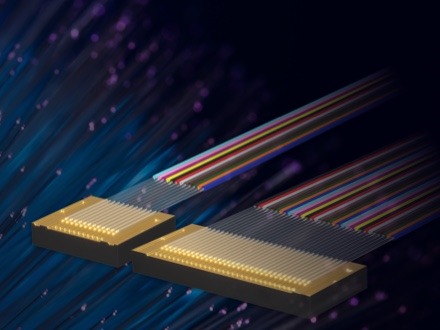Navigating The Data Tsunami: The Silent Challenge Behind AI’s Rise, And The Innovative Company That Might Hold The Key
Opinions expressed by Entrepreneur contributors are their own.
You’re reading Entrepreneur Asia Pacific, an international franchise of Entrepreneur Media.

Teramount is revolutionizing the way optical fibers are integrated with silicon photonics chips, addressing a complex challenge that has long impeded the broader application of this technology.
In the contemporary digital landscape, where artificial intelligence (AI) and machine learning (ML) are no longer just buzzwords but essential components of our daily lives, a less visible yet critical challenge looms large. This challenge is not about developing smarter algorithms or more powerful computing hardware but about something more fundamental: the infrastructure that enables the vast, rapid movement of data these technologies require. Before we delve into how Teramount is addressing this challenge, let’s understand the scale and nature of the problem.
The Bandwidth Bottleneck
As AI and ML applications become increasingly integrated into various sectors—from healthcare diagnostics to autonomous vehicles—the amount of data being generated and processed has skyrocketed. This surge in data, often referred to as the “data tsunami,” has put unprecedented pressure on the existing data transmission infrastructure. The crux of the issue lies in bandwidth and energy efficiency: our current systems, largely reliant on copper-based interconnects, are struggling to keep up with the demand for higher data throughput and lower latency while maintaining energy efficiency.
Silicon Photonics: A Beacon of Hope
Silicon photonics emerges as a promising solution to this conundrum, offering the potential for faster data transfer speeds and lower power consumption. By using light, instead of electrical signals, to transmit data, silicon photonics can dramatically increase bandwidth and reduce energy usage. However, integrating optical fibers—the conduits of light (and thus data)—with silicon chips has been a significant technical challenge. Precise alignment, manufacturing complexity, and cost have all been barriers to the widespread adoption of silicon photonics.
Enter Teramount
This is where Teramount comes into the picture, a company that has not just acknowledged these challenges but has taken innovative steps to overcome them. Teramount’s Universal Photonic Coupler transforms the landscape when it comes to how optical fibers integrate with silicon photonics chips. In layman’s terms, Teramount has developed a technology that simplifies the connection between the fibers that carry light (and thus data) and the chips that process this data. This innovation not only makes manufacturing easier and more cost-effective but also enhances the performance and reliability of silicon photonics systems.
Dr. Hesham Taha, CEO of Teramount, articulates the significance of their breakthrough: “Our Universal Photonic Coupler doesn’t just tweak the existing paradigm; it fundamentally transforms it. We’re making the connection between light-carrying fibers and data-processing chips not only simpler but also more efficient and robust. This is about enhancing the backbone of the digital world to accommodate the future of AI, IOT, and beyond.”
What Makes Teramount’s Technology Unique
Teramount is revolutionizing the way optical fibers are integrated with silicon photonics chips, addressing a complex challenge that has long impeded the broader application of this technology. Traditional methods of aligning optical fibers with chips required near-perfect precision, akin to threading a needle with a strand so fine it’s almost invisible, making the process both painstaking and expensive.
Teramount introduces a groundbreaking solution: the Universal Photonic Coupler, featuring self-aligning optics. This innovative approach significantly relaxes the precision needed for connecting fibers to chips, analogous to a magnet that effortlessly draws and secures the thread through the needle’s eye.
Central to Teramount’s technology are two innovative components: the Photonic-Plug and Photonic-Bump. The Photonic-Plug serves as an adaptable link, guiding light from the fiber to the chip with unmatched efficiency. Meanwhile, the Photonic-Bump, an advanced optical element, ensures that light is seamlessly transferred into the chip’s circuitry. Together, they not only simplify the manufacturing process but also enhance system performance by ensuring a more consistent and efficient light transfer.
By streamlining the fiber-to-chip connection, Teramount’s innovation is particularly pivotal for the advancement of Co-Packaged Optics (CPO). CPO is critical in enabling high-density, high-speed data transmission necessary for cutting-edge applications in AI, IoT, and beyond, by bringing optics into close proximity with the processor. This proximity poses packaging challenges, yet Teramount’s unique approach facilitates the integration of optical and electronic components within the same package, opening up new possibilities for silicon photonics’ application across various high-tech fields.
What this Technology Could Mean for Tech Giants
For companies like Nvidia, Apple or Amazon, incorporating Teramount’s universal photonic coupling technology could be transformative. It not only has the potential to boost the performance and reliability of their systems but also to make the production process more scalable and cost-effective.
For example, Nvidia, known for its high-performance GPUs that power AI and machine learning, could see reduced latency and increased bandwidth in data centers, potentially speeding up AI model training. This practical improvement means quicker development cycles for AI technologies, directly impacting the efficiency of operations reliant on Nvidia’s hardware.
Similarly, as data centers worldwide grapple with the escalating demands of data volume and speed, largely spurred by recent advancements, Teramount’s solutions stand out as pivotal for their evolution. For companies like AWS, Amazon’s cloud computing behemoth, the integration of Teramount’s technologies could significantly enhance its ability to provide faster and more reliable cloud services. This would arguably be especially critical for AWS’s comprehensive machine learning and data analysis offerings, which are fundamentally dependent on superior data throughput and swift processing capabilities.
Enabling a Future Powered by Light
As the digital world ventures further into realms of unprecedented data generation and consumption, the imperative for robust, efficient, and scalable infrastructure has never been clearer. Teramount, through its innovative solutions, seeks to offer the key to a future where our digital ecosystems are not just capable of keeping pace with technological advancements but are also primed to drive them forward. In this ecosystem, Teramount, if successful, could become the linchpin that ensures the seamless flow of tomorrow’s data on a global scale, making the most ambitious visions of a light-powered digital future attainable.


